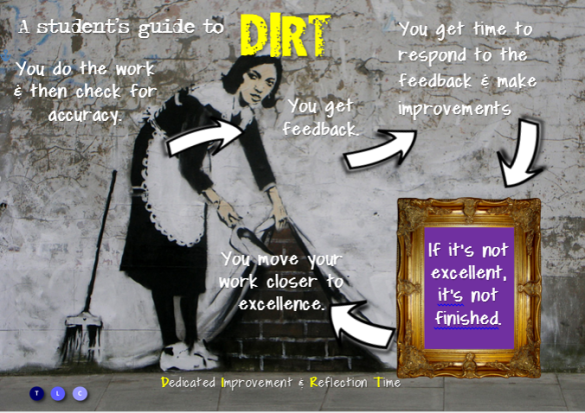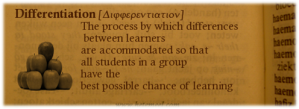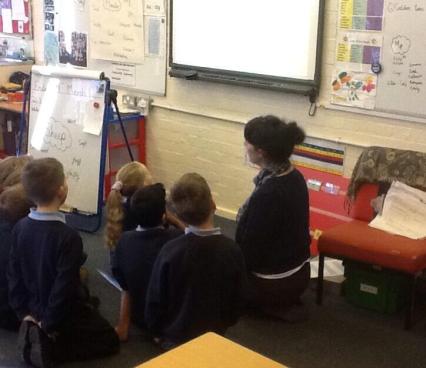Here are some brief notes from my recent workshop at #TMNSL 2014 which were also posted here.
Our students differ from each other in so many ways:
- Prior knowledge and expertise
- Ability
- Language development
- Motivation
- Interest
- Family background and values
- How they learn best
- Where and when they learn best
- Speed at which they learn
- Levels of concentration
- Confidence and self esteem
- Physique
This is not an exhaustive list but it would appear that it may be prudent to consider these factors when planning some great learning for our children.
There are several ways by which we can make the learning more accessible for all our learners…
- Task
- Resource
- Outcome
- Questions
- Time
- Steps to take in an activity
- Support – peer/adult/virtual
- Grouping
- Pupil choice
- Curriculum
- Assessment & feedback
The top two sound too much like hard work for busy teachers so in the workshop at #TMNSL 2014 we briefly looked at the possibilities of differentiating by choice.
Before though we considered the fact that John Hattie suggests that…
“A teachers’ job is not to make work easy. It is to make it difficult”.
He goes on to say that…
“If you are not challenged, you do not make mistakes. If you do not make mistakes, feedback is useless.”
Lev Vygotsky suggests that our students should operate within their ‘Zones of Proximal Development’. This involves facing challenges just beyond their current capabilities: a level of challenge that students can meet with help. Learning should feel tough, tricky, challenging, puzzling but not impossible.

Picture from http://www.simplypsychology.org/vygotsky.html
To provide a challenging level of learning we need to know our students. Ensure that you have simple, understandable and usable pupil data available and use this data when planning and structuring teaching and learning in your classroom. Data together with any other relevant information about your students is best collated on an annotated seating plan or student profile. Have this annotated seating plan to hand and in the forefront of your mind as you prepare fabulous lessons. Remember to also have their recently marked books with you too as marking should of course always inform your lesson planning.
Start with the end in mind: plan for learning. Establish a clear objective and tangible outcomes, avoiding the devil of low expectation – Must Should Could. Quite simply the wrong language to be using with teenagers!
Same task, different level of challenge. When you differentiate, you plan for the most able in terms of outcomes and then look at how to overcome the barriers for other groups in your class to enable them to access these outcomes – you then adapt resources, support and grouping to differentiate.
Research from Professor Robert Ornstein indicates that when learners feel as if they have some control and choice over the type of task that they are about to do, they feel more positive and motivated.
So try to differentiate through choice eg Let the students choose their level of challenge (seen here from one of our year three classes) or use workshops or drop in sessions: a series of inputs or demonstrations that students come to if, and only if, they need them (demonstrated here by one of our year three classes again). Attendance at the year three workshops is triggered by your teacher’s feedback in your book. More perceived choice really!

Maths options from BCA’s Year 3 Maple Class
Here is an example of a teacher who has allocated specific times to specific exam questions so that students may attend ten minute drop ins to support their undertsanding, if required.
Here are my differentiation top tips:
- Know your class and demonstrate this through up-to-date, annotated seating plans and student profiles. Use this ever-developing knowledge base to enable you to adapt your approach for who is in front of you. Gather information that enables you to connect to them as individuals.
- Challenge them and have really high expectations. Keep the bar high always and present learning without limits. Share excellence with them so they can see and understand your high expectations. Use modelling and explanation so that they are clear about what constitutes excellence.
- Encourage your students to make and learn from mistakes. Then feedback can come into play. Don’t be tempted to say “If you’ve got a problem, put your hand up and I will come and help”. Try to help them build resilience in the face of difficulty. Make them sweat.
- Opportunities for students to express their understanding and articulate their thoughts should be designed into any lesson. The more you hear and see the more you find out and the better you plan, respond and adapt to what happens during the lesson. Great teachers are great listeners too. Be a flexible, adaptive and responsive teacher.
- Mark their books and provide your students with more work. Provide them with an opportunity to make your suggested improvements: the only time you will ever have 30 different lesson plans – gold plated differentiation!

Here are my differentiation bookmarks.

My late great ‘freelance’ boss and colleague @paulginnis posted his 2009 ‘Different Differentiation’ booklet here.

The Teacher’s Toolkit by Paul Ginnis available here… http://www.amazon.co.uk/Teachers-Toolkit-Classroom-Achievement-Strategies/dp/1899836764
Please feel free to tweet me with your differentiation thoughts and ideas @chrismoyse. Will post some further ideas soon.




Reblogged this on The Echo Chamber.
Thank you for your interest in my blog. X
excellent blog Chris!
many thanks for taking the time to read it. Cheers Joe
Pingback: Differentiation | PGCEPhysicalEducation
Pingback: Open All Hours part 2 | Meols Cop High School
magnificent post, very informative. I wonder why the other experts of this sector don’t notice this. You must continue your writing. I am confident, you’ve a great readers’ base already!
Many thanks!!
Pingback: Interesting reads on differentiation, stretching learners and setting high expectations | joannemilesconsulting
Pingback: - Try This Teaching
Pingback: - Try This Teaching